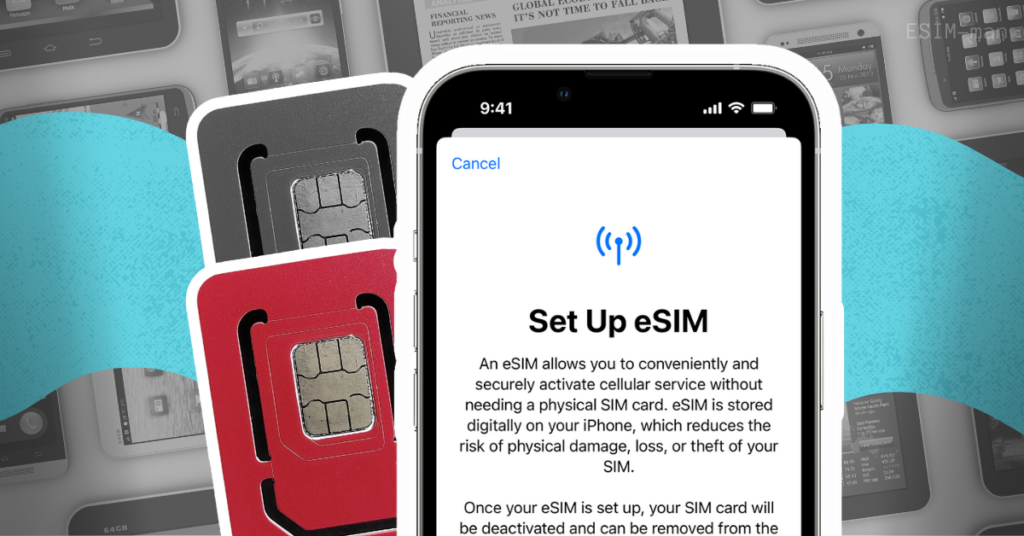Table of Contents
How many smartphone users do you think there are at the moment? 2 billion? 3 billion? In fact, at the beginning of 2023, there were about 4.5 billion active users, which is more than half of the entire population of our planet. Upon learning this interesting fact, the question does not even arise: “Are phones, cell phones and SIM cards (Dual and e-SIM) popular in the 21st century?”, because the answer is obvious.
Related: “Does Dual SIM use more battery than eSIM?“
Phones and mobile communication — The value in the 21st century
Mobile communications have been around for decades, but as for innovations in 4G or LTE connectivity, 5G developments, and evolutionary breakthroughs in chip varieties, the tabloids have been making colourful headlines over the past 10 years, with Dual SIM and eSIM becoming increasingly common.

It should be noted that gadgets have taken an important place in modern society for a number of reasons:
- One of the main functions of smartphones is to communicate at a distance. Electronic devices allow people to make phone calls, send text messages and use various messaging applications to communicate with others in real time, no matter where they are;
- With a phone, you have access to the Internet at your fingertips, which means you can search for information, news and events anytime and anywhere, keep up to date and stay in touch with friends and family;
- With cellular connectivity you have the opportunity to work remotely and also have access to a wide range of educational resources, online courses and e-books;
- Gadgets can help people stay organised and productive by allowing them to manage their schedules, set reminders and access productive apps such as calendars, to-do lists and note-taking apps.
And it’s not just productivity that’s worth mentioning, as devices provide a host of entertainment options, from music and movie streaming to games and social networking apps.
Phones have become an integral part of modern life, serving as a gateway to the world and allowing people to stay connected, informed and productive in today’s fast paced and interconnected world, but how does communication work, what do you know about Dual SIM meaning? What do we know about Embedded SIM?
The evolutionary revolution in SIM cards
The e-SIM has been a real breakthrough in the field of cellular telephony, and is slowly making its way into modern life. MFF2 technology: the M2M form factor is an integrating small chip that can be found in almost all the latest smartphone models.

It’s interesting that the benefits of the eSIM look like this:
- Thanks to Embedded SIM technology, you can easily switch between different carriers and tariff settings without having to physically change your SIM card;
- e-SIM helps reduce the cost of international roaming, as users can purchase and activate a local eSIM plan while travelling instead of paying high roaming charges to their home carrier;
- The MFF2 offers increased security and protection against spoofing or cloning SIM cards.
However, what about the Dual SIM vs eSIM comparison?
Pros and cons of Dual SIM
Dual SIM devices are electronic devices that have two standard sized chips in their “brains” for a physical SIM. The best way to talk about a SIM card with 2 chips is with pros and cons.
What benefits of Dual SIM you can get:
- 2 SIM phones allow you to communicate seamlessly on a personal physical card as well as on a work mobile with a corporate rate – this is handy when travelling, as there is no need to switch between numbers as well as overpay for the connection;
- You will be able to use a local sim card, which you can buy in local shops when you travel, without having to take your main number out of your phone;
- If network coverage is poor on one card, you can switch to another in seconds and still be in touch.
Disadvantages of Dual SIM mobile phones:
- Using two chips can drain a phone’s battery faster than using one;
- Some Double SIM smartphones may not support certain features or services when both physical media are used at the same time, for example mobile hotspot or Wi-Fi calling;
- Electronic devices with two chips may be larger and heavier than phones with one, which can make them less portable and easier to carry.
Comparative analysis of eSIM and Dual SIM
When it comes to the difference between eSIM and Dual SIM, the following points can be highlighted:
- Gadgets with two physical electronic carriers are much larger and heavier than e-SIM devices;
- Embedded SIM allows to connect up to 10 profiles with different carriers while in a Double SIM phone only 2 plans are possible;
- MMF2 may be more secure than physical chips as they are more difficult to clone or duplicate.
Summary
The take-home message is that e-SIM technology offers a number of advantages over traditional physical SIMs, including convenience, cost savings, flexibility, security, stability, and ease of activation. As more and more devices become Embedded SIM enabled, it is likely that the use of the technology will continue to grow and become more widespread in the future, displacing Dual SIM altogether.






